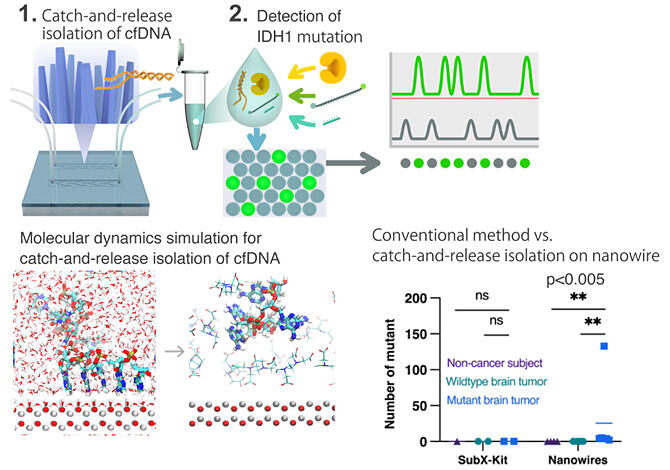Early diagnosis of brain tumors is important for increasing survival rates, but they are frequently discovered only after the appearance of symptoms such as paralysis of the limbs, and they are generally so advanced that their complete removal by surgery is often difficult.
The research group led by Professor Yoshinobu Baba and Professor Takao Yasui of the Graduate School of Engineering, Nagoya University (Concurrently a Professor at Tokyo Institute of Technology) along with Designated Professor Atsushi Natsume of the Institutes of Innovation for Future Society, Nagoya University, Professor Takeshi Yanagida of the School of Engineering, the University of Tokyo, and Associate Professor Sakon Rahong of King Mongkut's Institute of Technology Ladkrabang in Thailand. They collaboratively developed the catch-and-release technology for urinary cell-free DNA (cfDNA) on the surface of nanowires and succeeded in detecting the mutation of dehydrogenase-1 (IDH1), a gene mutation in glioma. The development of this technology is likewise expected to detect mutations in urinary cfDNA of other cancer types that could not be isolated by conventional methods. The result was published in the academic journal Biosensors and Bioelectronics.

Provided by Nagoya University
cfDNA has been approved by FDA as a noninvasive cancer biomarker, and its clinical significance is still being emphasized by NIH and liquid biopsy societies worldwide. In particular, urinary cfDNA is expected to be a true noninvasive biomarker due to extremely easy sample collection for monitoring in cancer screening, diagnosis, prognosis, cancer progression, and therapeutic effect; however, the lack of efficient cfDNA isolation technology is a major bottleneck because the cfDNA concentration in urine is relatively low.
The research group has so far developed an all-in-one platform that simultaneously captures extracellular vesicles and detects membrane proteins by arranging nanowires on the bottom of a well plate. In these developments, they overcame the inefficient cfDNA isolation by proposing and demonstrating the catch-and-release of cfDNA on the surface of nanowires for the application to urine liquid biopsy. Zinc oxide (ZnO) nanowires, which enabled extracellular vesicle trap and brain tumor detection in the previous work, were utilized here for glioma mutation detection by cfDNA isolation.
First, they tried to clarify the mechanism of catching and confirmed that cfDNA in urine was captured by hydrogen bonding with water molecules on the surface of ZnO nanowires at multiple points.
They subsequently verified that cfDNA was removed by introducing a molecule capable of competitive binding to ZnO that was hydrogen-bonded with cfDNA. Through this technique, they successfully isolated cfDNA from urine and detected IDH1 mutation, the genetic mutation in glioma, from urinary cfDNA, both of which were impossible by the conventional method. This is the first report of the IDH1 mutation detection from 0.5 mL of urine sample.
The results are expected to develop into the detection of cancer subtype mutation by isolating urinary cfDNA, especially those of other cancer types that could not be isolated by conventional methods.
Journal Information
Publication: Biosensors and Bioelectronics
Title: Mutation detection of urinary cell-free DNA via catch-and-release isolation on nanowires for liquid biopsy
DOI: 10.1016/j.bios.2023.115318
This article has been translated by JST with permission from The Science News Ltd. (https://sci-news.co.jp/). Unauthorized reproduction of the article and photographs is prohibited.




